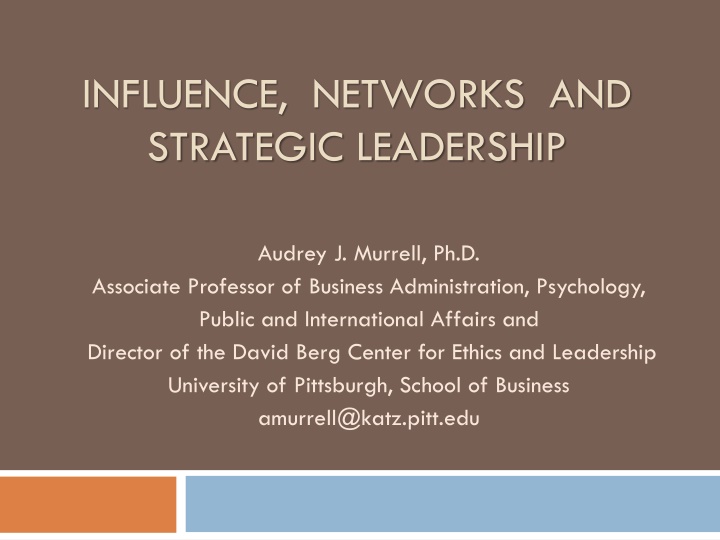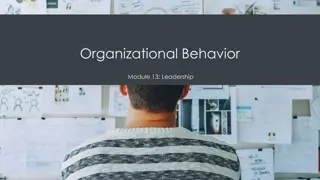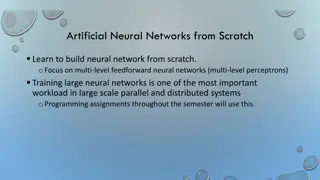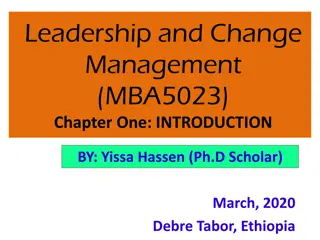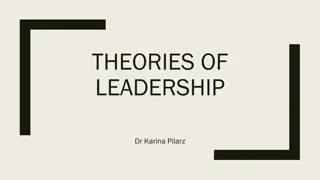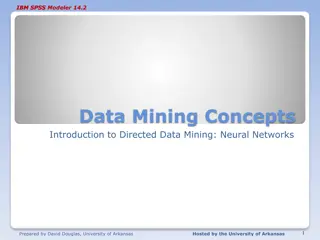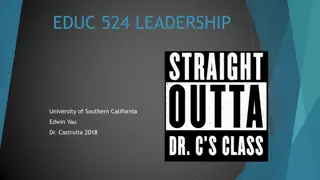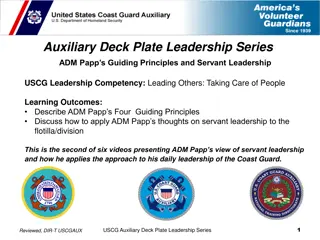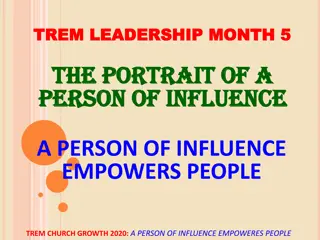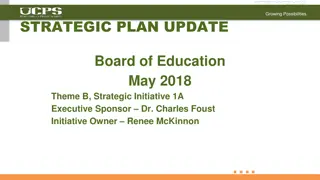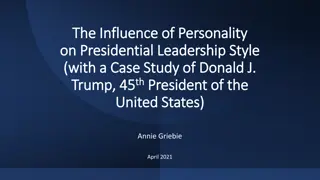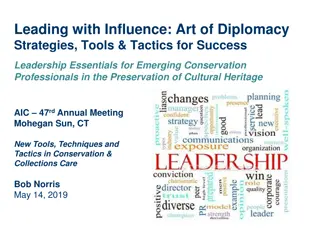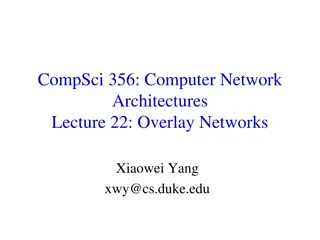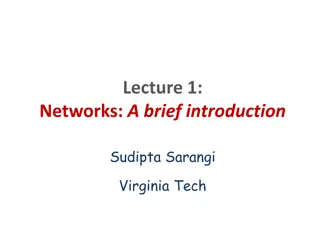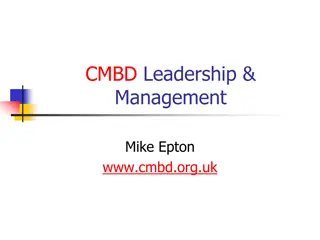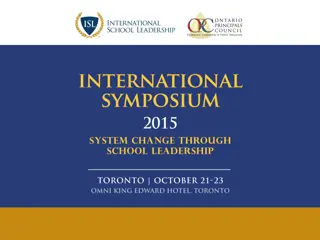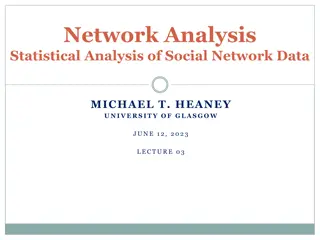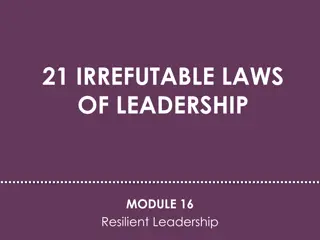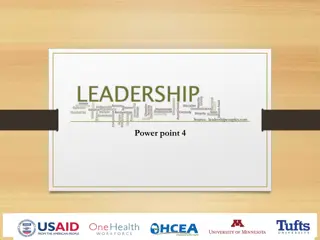Insights on Influence, Networks, and Strategic Leadership
Explore the role of strategic leadership in complex organizations, delve into the connection between leadership and organizational change, and enhance self-awareness of leadership strengths and areas for improvement. Key issues in Prairie Health Services, leadership myths, effective managerial traits, and the realities of managing and leading are discussed.
Download Presentation

Please find below an Image/Link to download the presentation.
The content on the website is provided AS IS for your information and personal use only. It may not be sold, licensed, or shared on other websites without obtaining consent from the author.If you encounter any issues during the download, it is possible that the publisher has removed the file from their server.
You are allowed to download the files provided on this website for personal or commercial use, subject to the condition that they are used lawfully. All files are the property of their respective owners.
The content on the website is provided AS IS for your information and personal use only. It may not be sold, licensed, or shared on other websites without obtaining consent from the author.
E N D
Presentation Transcript
INFLUENCE, NETWORKS AND STRATEGIC LEADERSHIP Audrey J. Murrell, Ph.D. Associate Professor of Business Administration, Psychology, Public and International Affairs and Director of the David Berg Center for Ethics and Leadership University of Pittsburgh, School of Business amurrell@katz.pitt.edu
Our Objectives Understand the role of strategic leadership in complex and dynamic organizations Discuss the connection between leadership and effective organizational change Examine key concepts such Tipping Point and Level 5 leadership in organizations Enhance self-awareness of one s own leadership strengths and opportunities for improvement
Prairie Health Services (PHS) What are some of the key issues described in this case? Who are the key people that we need to understand and discuss? What aspects of leadership effectiveness or ineffectiveness are evident in the case? What other issues should be identified and discussed?
The Myths of Effective Leadership If I have the authority, I can get things done. It s important for me to have direct control over the things that I am responsible for in the organization. A key factor in my success is being given the power to direct the work of others. Change does not happen here unless the person with the title says so.
What Effective Managers Do Effective managers (Kotter): Develop and utilize both technical and relational competencies Devote significant time agenda building within the organization Recognize that power and influence are often gain without formal title or authority Spend significant time cultivating diverse relationships within the organization
What It Really Means to Effectively Manage & Lead Myth Authority Formal Position Dependency only on subordinates Control and compliance are goals Use of technical skills Reality Interdependency Informal relationships Peers and others outside formal lines Commitment and empowerment are goals Use of technical and social skills
Sensemaking Process of coming to understand the context in which you (and others) are operating within Must seek many types and sources of data Involve others in the process Avoid overuse of personal schema/biases Learn from small experiments Use images, metaphors and stories to help communicate
Tipping Point Leadership In many turnarounds, the hardest battle is simply getting people to agree on the causes of current problems and need for change ~ Kim and Mauborgne
Tipping Point Leadership How do we get the key message or issue to stick? Overcoming Hurdles: Cognitive Hurdle Put people face-to-face with problems and customers; finding new ways to communicate Resource Hurdle Focus on the hot spots and negotiation with key partners Motivational Hurdle Highlight commons interests/identities and frame the challenge to match organizational goals/mission Political Hurdle Address internal and external opponents
Tipping Point Leadership Key Action Steps: Cognitive Hurdle Develop and execute an internal communication strategy Resource Hurdle Refocus resources pay attention to organizational currency Motivational Hurdle Engage key influencers Political Hurdle Focus on the 80-20 rule
Sensemaking at PHS For group discussion: What is the key issue at PHS that needs to become sticky What hurdles should be the focus in order to help make the key issue tip ? What are some specific steps that should be take here and who is key to their success?
Relating Creating relationships, managing the relationship aspects of the organization thru building social capital and trust in leadership Spend time understanding the perspective of others Encourage real participation Develop connections and important advice networks Develop social capital inside and outside the organization
Level 5 Leadership Level 5 refers to the highest level in a hierarchy of executive capabilities that we identified during our research. Leaders at the other four levels in the hierarchy can produce high degrees of success but not enough to elevate companies from mediocrity to sustained excellence. Good-to-great transformation don t happen without Level 5 leaders at the helm. They just don t. ~ Jim Collins
From Good to Great Collins and research team studied companies that made the leap from good results to great results and sustained those results for at least 15 years Firms studied outperformed the market over the 15 year period Key question asked was Can a good company become a great company and if so, how?
Level 5 Leadership Level 5: Builds enduring greatness thru personal will and humility Level 4: Catalyzes commitment to clear and compelling vision Level 3: Organizes people and resources toward key objectives Level 2: Contributes to achievement of common goals Level 1: Makes productive contribution thru knowledge, skills & hard work
Level 5 Leadership Professional Will Ferocious resolve, stoic determination Demonstrates an unwavering resolve to do whatever much be done Sets the standards of building an enduring company inspired standards Never blames other people or external factors or bad luck for negative outcome Yes, leadership is about vision. But leadership is equally about creating a climate where the truth is heard and the brutal facts confronted. There s a huge difference between the opportunity to have your say and the opportunity to be heard. The good-to- great leaders understood this distinction, creating a culture wherein people had a tremendous opportunity to be heard and ultimately, for the truth to be heard.
Level 5 Leadership Personal Humility Compelling modesty Acts with calm, quiet determination Relies on inspired standards rather than inspired charisma Channels ambition into the company Focuses on leadership and management succession to surpass their own success Leading from good to great does not mean coming up with the answers and then motivating everyone to follow your messianic vision. It means having the humility to grasp the fact that you do not yet understand enough to have the answers and then to ask the questions that will lead to the best possible insights .
Key Findings Larger-than-life, celebrity leaders negatively correlated with taking a company from good to great No systematic pattern linking specific forms of executive compensation to going from good to great Neither strategy, technology or mergers per se predicted who was identified as a good to great firm Good to great companies were not in great industries, but terrible industries Those who build great companies understand that the ultimate throttle on growth for any great company is not markets, or technology or competition, or products. It is one thing above all others: the ability to get and keep enough of the right people. Level 5 Leadership produces a irony in that personal ambition that drives people to positions of power conflict with the qualities of success at this level Boards of Directors frequently operate under the false belief that a larger than life charismatic leader is what will make the company successful this may be why there is a dearth of this type of leader
Level 5 Strategies Attend to people first, strategy second Confront the most brutal facts of the current reality Focus on executing consistent and sustained approaches for transformation Focus people s attention on 3 keys concerns: What our company can be the best in the world at How our economies work best What best ignites the passion of our people
Relating at PHS For group discussion: Evaluate the CEO at PHS in terms of the concepts of Level 5 Leadership How might professional will be a positive or negative factor in this case? What role might personal humility play in the overall effectiveness of the CEO as a leader? What advice might you give to Carl on how to improve his overall effectiveness as a leader based on these concepts?
Inventing Capability to change the way people work together and think about their work Involves key aspects of team design, building and leading Focuses on executing, change and implementation of vision Captures the ability to create innovative and creating solutions, processes and outcomes
Why Change Fails Not establishing a great enough sense of urgency Not creating a powerful enough guiding coalition Lacking a vision Under-communicating the vision by a factor of ten Not removing obstacles to the new vision Not systemically planning for, and creating short- term wins Declaring victory too soon Not anchoring changes in the corporation s culture
Kotters Change Process 8. Anchor new approaches in the culture 7. Communicate gains; produce more change 6. Generate short-term wins 5. Empower broad-based action 4. Communicate the change vision 3. Develop a vision and strategy 2. Create the guiding coalition 1. Establish a sense of urgency
Change Requires Communication High DIALOGUE Telling Exploring each other s assumptions to generate meaning Asserting Explaining ADVOCACY Asking Observing Clarifying Interviewing Bystanding Sensing Low Low High INQUIRY Peter M. Senge et al., The Fifth Discipline Fieldbook
Change Requires Collaboration Senior Executive Network Government Agencies YOUR INNER CIRCLE Suppliers Customers Networks in Other Departments NGOs
Change Requires Currency Task-related Resources Assistance Information Position-related Advancement Visibility Reputation Networks Relationship-related Personal support Understanding Validation Personal-related Learning Ownership Expertise identity
Key Action Steps for Creating Change Establish a sense of urgency Identify specific threats, smoldering crises or major opportunities Form a powerful guiding coalition Assemble a group with power and currency to lead and implement change effort Create and communicate a vision Understand how to meet people where they are Plan for and create short-term wins Use evidence and data on outcomes to make a case for change
Can change be too slow? Karl Weick: Emergent changes can be slow to cumulate; too small to affect outputs or outcomes; less well suited for responding to threats than for exploiting opportunities; limited by pre- existing culture and technology; deficient when competitors are wedded to transformation; better suited to implementation in operations, plants and stores than to strategy, firm-level or corporate change .
Can Change Be Too Radical? Karl Weick: The liabilities of planned change include a high probability of relapse; uneven diffusion among units; large short-term losses that are difficult to recover; less suitability for opportunity-driven than for threat-driven alternations; unanticipated consequences due to limited foresight; temptations toward hypocrisy (when people talk the talk of revolution but walk the walk of resistance) .
Inventing at PHS For group discussion: Among Kotter s reasons why change fails, which ones are most relevant to PHS? Examine Ann Smith s role as an change agent within the case in what ways is she effective or ineffective in this role? What advice might you give to Ann on how to improve her overall effectiveness as an agent of change within PHS?
Visioning Creating and communicating a compelling shared image of the future Focus on framing of visions to reach key stakeholder groups Visions must be shared, compelling and sincere Issues selling strategies are important for communicating vision Vision must be followed by action walking the talk is key
Agenda Building Agenda building involves reconciling diverse and conflicting expectations by developing one common agenda and course of action Involves activities and competencies such as: Managing trade-offs across key currencies Negotiating across diverse interests Analyzing the cultural and political environment
Agenda Building Understanding who sets (and the process) the organization s agenda Agenda building involves reconciling diverse and conflicting expectations by developing one common agenda and course of action Involves activities and competencies such as: Managing trade-offs and conflict Negotiating across diverse interests Analyzing the cultural and political environment
Issue Selling Critical pathways for managers to raise issues of importance Reflects key tactics for effective agenda-building Illustrates the importance of change from the middle Includes attempts by lower level managers to influence higher level members of organization Issue selling important to both organizations and leaders: Today s leaders are challenged to cope with complex business world Issue selling allows many minds to contribute in organization s future These minds may be closer to problem areas and thus offer important perspectives
Bundling Linkages of new issue to existing issues Requires understanding of how issues get on firm s agenda Can tap into resources and support based on current issue Can backfire or become tainted because of negative issue and/or perceived failure
Framing Framing impacts how choices are evaluated Issues can be framed as an opportunity or a threat Framing an issue as an opportunity can induce greater participation, commitment to taking action versus framing an issue as a threat Framing also makes a choice of: Responsibility vs. obligation Moral/ethical vs. business case Internal vs. external Idea focused vs. data driven Emotional vs. logical
Language Related to issue framing Relies heavily on understanding of the cultural lens Language is tailored to the focal target group or groups Key issue is focusing on: Purpose Audience Context Obstacles
Involvement Involves issue selling as a process Must identify critical stakeholders and understand the role and impact of participation Factors such as effective use of teams, negotiation, coalition building and networks are relevant Focuses on the importance of change champions/sponsors and change implementers/agents
Approach Individual skills and strategies for issue selling Key choices involve: Formal vs. informal Individual vs. team Public vs. private Must be able to communicate across function, interpersonal style and organizational role/position
Timing Must understand both the political and cultural context of the organization Key factors are momentum, windows of opportunities and social/organizational climate Must understand the phases and cycles of change in organization
Issue Selling Challenges Understanding managers choice processes in deciding to sell issues People more willing to sell issues in contexts where they perceive management will listen and where context is experienced as supportive Context may enhance or inhibit issue selling Issue sellers often worry about damaging their reputations Leaders plays important role in issue selling because they set context for subordinates Issue selling is difficult in conflict avoiding organizational cultures Charged issues are tough, problematic, sensitive issues that sellers may be reluctant to raise Examples of charged issues: Outsourcing Restructuring Diversity/Inclusion Treatment of the natural environment
Visioning at PHS For group discussion: You have just been informed by CEO Carl Nord that the board has asked for a presentation from the team that reviewed the proposals for the new technology. You will have 5 minutes to make a pitch to them on your ideas/recommendations. Carl will be present during your presentation to the board. The board will meet again in 10 days to review/decide. Taking the role of the evaluation team, outline your strategy for how you can begin to make change at PHS.
